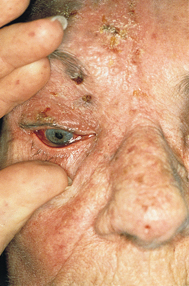MKSAP Quiz: Increasing headache and red eye
A 64-year-old man is evaluated for a new right-sided headache that began 1 day ago. He awoke yesterday with a dull ache over his right forehead that has gradually increased in intensity. He also notes some right eye discomfort, sensitivity to light, and that his eye is red.
Vital signs are normal. The patient is uncomfortable and prefers to have the lights dimmed. Physical examination findings are shown. The right eye has diffusely injected conjunctiva and the cornea appears clear. The left eye is normal. The pupils are equal and reactive. Visual acuity is normal. Cranial nerves are intact.

Which of the following is the most likely diagnosis?
A. Herpes simplex virus keratitis
B. Herpes zoster ophthalmicus
C. Scleritis
D. Trigeminal neuralgia
Answer and critique
The correct answer is B: Herpes zoster ophthalmicus. This question can be found in MKSAP 15 in the General Internal Medicine section, item 104.
This patient has a localized headache associated with unilateral eye pain. There is conjunctival injection localized to same side of the headache and a skin eruption in the distribution of the first branch of the trigeminal nerve. This presentation is most consistent with a diagnosis of herpes zoster ophthalmicus. A zoster eruption in the first branch of the trigeminal nerve may involve the eye and cause blepharitis, conjunctivitis, keratitis, uveitis, ophthalmoplegia, or optic neuritis.
Herpes zoster ophthalmicus (which includes any involvement of the structures of the eye) is an ophthalmologic emergency, as it is potentially sight threatening. A particularly high-risk lesion is when zoster involves the tip of the nose, as this is the nasociliary branch of the trigeminal nerve and thus also innervates the cornea. All patients with a zoster eruption in the territory of the first branch of the trigeminal nerve should be emergently referred to an ophthalmologist to rule out eye involvement, even if only the skin appears to be involved, as deeper structures of the eye can be affected.
Herpes zoster ophthalmicus should be distinguished from herpes simplex virus (HSV) infection of the eye, which can cause inflammation and infection of the cornea (keratitis). HSV keratitis presents acutely with pain, blurred vision, and eye weeping; chemosis and conjunctivitis are present on physical examination. HSV keratitis differs from the conjunctivitis of herpes zoster in that it is not associated with a cutaneous eruption in a dermatomal pattern.
Scleritis is a painful, localized or diffuse, raised hyperemic lesion. Scleritis can cause deep, boring ocular pain but is not associated with a cutaneous eruption, making it an unlikely diagnosis for this patient.
Trigeminal neuralgia is typically characterized by excruciating, paroxysmal pain in the distribution of the trigeminal nerve. Although this patient's pain was localized to the trigeminal region, the presence of a skin eruption makes this an unlikely diagnosis.
Key Point
- Herpes zoster ophthalmicus is an ophthalmologic emergency and requires immediate referral to an ophthalmologist and institution of antiviral therapy.





